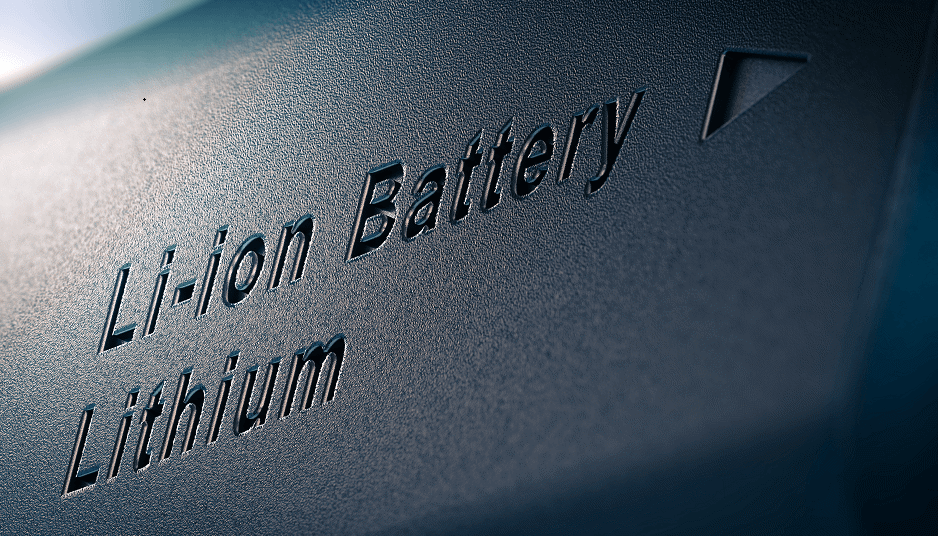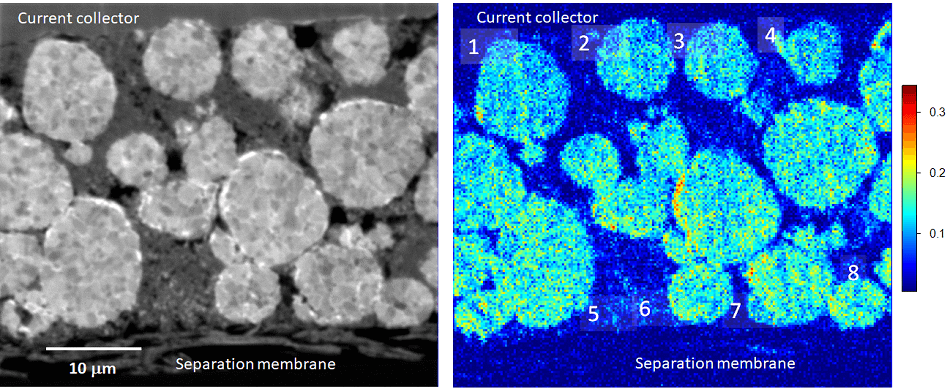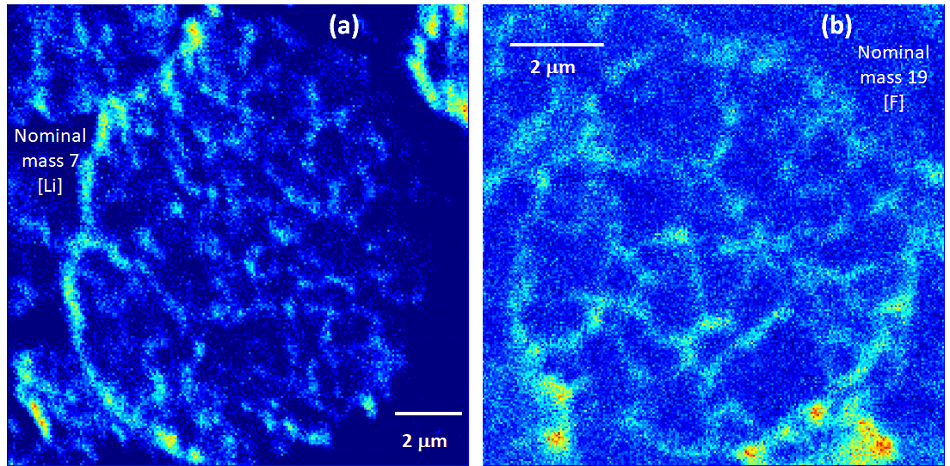
Image Credit: Olivier Le Moal/Shutterstock.com
Lithium ion batteries are the leading energy storage solution used in electronic devices and state-of-the-art hybrid electric vehicles. In order to improve performance, the chemical processes and species present in different areas of the cell and electrode need to be better understood. A significant challenge is understanding the Li ion distribution in electrochemical cells because Li is very difficult to detect by many common analysis techniques such as EDX, XRD and XAS. In contrast, Time-Of-Flight Secondary Ion Mass Spectrometery (TOF-SIMS) offers a very powerful way to measure Li, including its spatial distribution in a material even for very low concentrations. Thus, TOF-SIMS provides an excellent avenue to better understand the behaviour of Li ion batteries.
During cycling of a lithium ion battery, differences in reaction rates across an electrode can produce inhomogeneous degradation of electrochemically active particles, especially at high cycling rates. This means that there may be lithium present in different crystalline forms that can be detrimental to the operation of the cell. For example, capture of Li in reaction phases may reduce its functional life. Mapping the chemical composition and Li distribution in lithium cells is an important step in understanding their function and improving performance.
Application of Multi-Modal Correlative Microscopy
Characterisation of structure, chemical composition (Li, F and Mn) and elemental distribution in Li-ion battery materials can reveal the relationship between Li ion transport, structural effects (phase transformation, internal stress), battery performance and degradation. A novel method to accomplish this is the combination of focused ion beam and scanning electron microscopy (FIB-SEM) with TOF-SIMS. Nanoscale mapping of Li, Mn and F distributions has the potential to reveal the microstructural costs of the electrochemical reaction. This also allows the identification of Li ‘trapping’ sites within the structure, which can influence performance.

Figure 1. (a) Ion image and (b) top projection SIMS image for mass 7Li of the entire electrode cross-section.
Advantages of FIB-SEM and TOF-SIMS
TOF-SIMS is an extremely sensitive analytical method able to provide chemical characterisation of material surfaces. It does this by using a focused ion beam of Xe+ at an energy of 10-30 keV on the surface of the sample electrode. Secondary ions (SI) are emitted from the top atomic layers of the specimen and these secondary ions are measured by a mass spectrometer. TOF-SIMS provides a characterisation of a materials through mass spectra, depth profiles and elemental/molecular maps. Mass spectra allow the identification and quantification of elements and molecular species present in a sample. TOF-SIMS can achieve better lateral and depth resolution compared to other common chemical analytical SEM techniques such as EDX because of the lower interaction volume of Xe+ ions. Additionally, 3D chemical characterisation with high mass resolution and high spatial resolution imaging is also possible. TESCAN secondary ion mass spectrometry is based on the combination of an orthogonal TOF-SIMS analyser with a TESCAN FIB-SEM system. This enables in-situ FIB depth profiling with high mass resolution and high spatial resolution imaging. The superior performance provided by the coupling of TOF-SIMS with FIB-SEM allows the production of a range of 3D chemical characterisation and molecular information from a range of complex solid materials such as electrodes.
Lithium Study
In a recent study1 the global and local distribution of Li in an aged cathode from a discharged cell was measured using a TESCAN FERA Xe+ plasma FIB-SEM configured with TOFWERK TOF-SIMS system. Measurements focused on the cathode of an NCM523/graphite full cell that had endured 400 cycles of 3.0-4.4 V at 30°C. The cell exhibited a 40% loss of capacity as well as a significant rise in impedance due to changes in the positive electrode. The high current Xe+ plasma FIB facilitated preparation of large area cross-sections that allowed both global and local measurement of Li in the positive electrode using TOF-SIMS. The results showed both global and local variations in Li distribution as well as the presence of fluorine that could only have come from the electrolyte. For example, Figure 1 shows the Li distribution in a cross-section across the entire electrode. The region near the current collector at the top of the images (with particles labelled 1-4) shows a lower Li content than those particles near the separation membrane at the bottom of the figure (particles 5-8). Local regions with higher concentration of Li were correlated with regions of high F concentration, suggesting that reactions between the electrolyte and Li occur, rendering the Li immobile and thus unavailable for cycling. These effects are exacerbated by structural changes that take place during cycling. Cathode particles showed voiding, cracking and fragmentation. Since the side reactions take place at cathode surfaces, this cracking exposes more surface for reaction, binding more Li into inactive phases on these newly exposed surfaces. This is shown in Figure 2. Figure 2a shows the Li distribution in a single particle and reveals variations even on this local scale, with a significant enhancement of Li at the periphery of the particle and at grain boundaries within the particle. Figure 2b shows the F distribution in a companion particle. F is well correlated with the Li-rich regions at the periphery of the particle and also along grain boundaries within the particle. The synergistic effect of these changes as revealed by TOF-SIMS is especially detrimental to lithium ion battery performance.

Figure 2. Top projection SIMS images from single cathode particles (a) for nominal mass 7 corresponding to Li and (b) for nominal mass 19 corresponding to F.
Conclusion
TOF-SIMS integrated within FIB-SEM is a powerful approach to evaluate the spatial distribution of Li in Li ion batteries. The versatility of FIB allows it to be used to prepare cross-sections and then to provide the primary ion beam for TOF-SIMS measurement of Li distribution at both the electrode and single particle length scales. This approach was used to evaluate the microstructure of an aged Li ion cell and the results suggest heterogeneous Li distribution and reaction phases play a role in limiting Li mobility and lead to reduced performance and life of lithium-ion cells.
References and Further Reading
- D.J Miller, D Zapotok, P.Anzalone, T. Samoril, L. Hladik, H. Tesarova, K.P.C Yao, V.A Maroni, D.P. Abraham, et al., Exploring Li distribution in Li-ion batteries with FIB-SEM and TOF-SIMS, Microscopy & Microanalysis 24 (S1) pp. 370-371 (2018)
Additional Reading
- Multi-Modal FIB-SEM Analysis of Li-ion Batteries – https://www.azom.com/article.aspx?ArticleID=15344
- Tan Sui, Bohang Song, M. Korsunsky et al., Nanoscale chemical mapping of Li-ion battery cathode material by FIB-SEM and TOF-SIMS multi-modal microscopy, Nano Energy, Volume 17, October 2015, Pages 254-260.
- J.-M. Tarascon, M. Armand, et al., Issues and challenges facing rechargeable lithium batteries. Nature 2000, 414, 359–367.
- I.V.Veryovkin, C.E.Tripa, A.V.Zinovev, et al., TOF SIMS characterization of SEI layer on battery electrodes, Nuclear Instruments and Methods in Physics Research Section B: Beam Interactions with Materials and Atoms, Volume 332, 1 August 2014, Pages 368-372.
- Wei Zhang, Hui-Chia Yu, Lijun Wu, et al., Localized concentration reversal of lithium during intercalation into nanoparticles, Science Advances, 12 Jan 2018, Vol. 4, no. 1.
TESCAN Group
Founded in 1991 by a group of managers and engineers from Tesla with its electron microscopy history starting in the 1950’s, today TESCAN is a globally renowned supplier of Focused Ion Beam workstations, Scanning Electron Microscopes and Optical Microscopes. TESCAN’s innovative solutions and collaborative nature with its customers have won it a leading position in the world of nano- and microtechnology. The company is proud to participate in premier research projects with prominent institutions across a range of scientific fields. TESCAN provides its clients with leading-class products in terms of value, quality and reliability. TESCAN Group is the North American arm of TESCAN Group, a multinational company established by the merger of Czech company TESCAN, a leading global supplier of SEMs and Focused Ion Beam workstations, and the French company ORSAY PHYSICS, a world leader in customized Focused Ion Beam and Electron Beam technology.

This information has been sourced, reviewed and adapted from materials provided by TESCAN Group.
For more information on this source, please visit TESCAN Group.